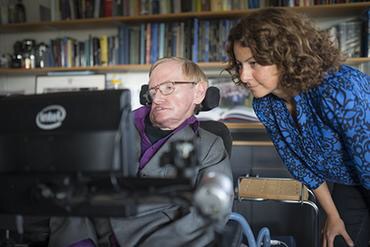Intel helps Stephen Hawking speak up

Stephen Hawking and Lama Nachman, a principal engineer of Intel labs. Intel
Living with a neurodegenerative condition that renders him almost completely paralyzed, Stephen Hawking relies on a computer system to communicate with others.
But the system he’s been using is now decades old, clumsy and time-consuming. So Intel — looking to give the renowned British scientist a new voice — worked with Hawking for three years to give him a new communication platform. On Tuesday in London, the tech giant unveiled Hawking’s new, custom-built system — called ACAT, or Assistive Context Aware Toolkit — that is twice as fast as his old system.
The Intel platform will become available for free to researchers and developers next month, with the hope that it could become the foundation for a modern communication system to help people with motor neuron diseases and quadriplegia. Intel’s new toolkit can be customized for different users, and be enabled by touch, eye blinks, eyebrow movements or other inputs for communication.
“The development of this system has the potential to improve the lives of disabled people around the world,” Hawking said in a statement, ” and is leading the way in terms of human interaction and the ability to overcome communication boundaries that once stood in the way.”
Hawking and more than 3 million people worldwide live with motor neuron diseases such as amyotrophic lateral sclerosis, or ALS. Such conditions, which have few known causes, progressively take away a person’s ability to control muscle movements and eventually lead to death. Systems like the one Intel created could help those living with such conditions to more easily communicate with others and remain independent for longer using whatever physical functions they still have.
With Hawking’s regular input, a team of researchers at Intel Labs made a communications system using Intel-created software. The result was a platform that’s faster, more accurate and allows for significant improvement of simple tasks, such as navigating the Web, opening a new document or switching between tasks.
For example, to perform a Web search, Hawking previously had to exit from his communication window, move a mouse to run the browser, navigate the mouse again to the search bar and type the search text. The new system automates all of these steps.
Hawking’s existing cheek sensor is detected by an infrared switch mounted to his glasses and helps him select a character on the computer. Software from SwiftKey, a British company offering a mobile app that predicts people’s typing patterns, lets Hawking type far fewer characters to communicate. The information is sent to his existing speech synthesizer so he can communicate to others through his Lenovo laptop.
“Technology for the disabled is often a proving ground for the technology of the future,” Lama Nachman, a principal engineer at Intel Labs, said in a statement. “From communications to genetic research, technology is beginning to open doors to possibilities that can only be imagined.”
IMPORT:-CNET

